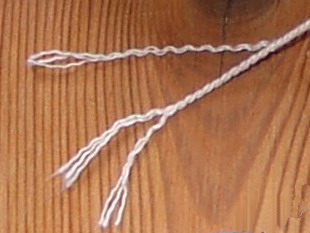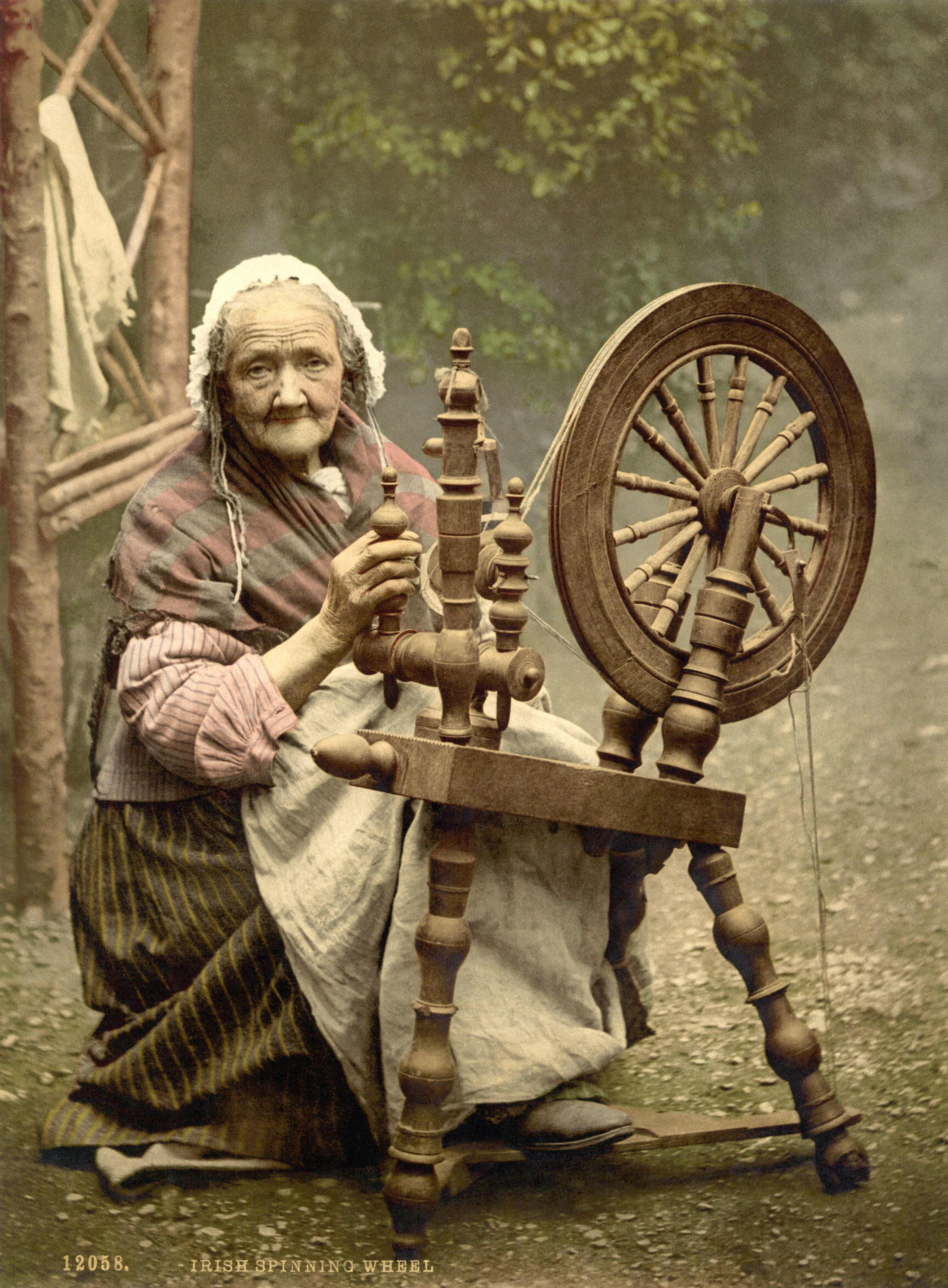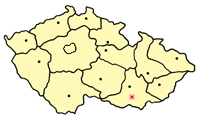|
Twine
Twine is a strong thread, light string or cord composed of two or more thinner strands twisted, and then twisted together ( plied). The strands are plied in the opposite direction to that of their twist, which adds torsional strength to the cord and keeps it from unravelling. This process is sometimes called reverse wrap. The same technique used for making twine is also used to make thread, which is thinner, yarn, and rope, which is stronger and thicker, generally with three or more strands. Natural fibres used for making twine include wool, cotton, sisal, jute, hemp, henequen, paper, and coir. A variety of synthetic fibres are also used. Twine is a popular substance used in modern-day crafting. Prehistoric The invention of twine is at least as important as the development of stone tools for early humans. Indeed, Elizabeth Wayland Barber has called the development of twine, which can be made far stronger and longer than its component fibers, "the string revolution." Twi ... [...More Info...] [...Related Items...] OR: [Wikipedia] [Google] [Baidu] |
String (cord)
String is a long flexible structure made from fibers twisted together into a single strand, or from multiple such strands which are in turn twisted together. String is used to tie, bind, or hang other objects. It is also used as a material to make things, such as textiles, and in arts and crafts. String is a simple tool, and its use by humans is known to have been developed tens of thousands of years ago.Susan Toby Evans, David L. Webster, ''Archaeology of Ancient Mexico and Central America: An Encyclopedia'' (2013), p. 812. In Mesoamerica, for example, string was invented some 20,000 to 30,000 years ago, and was made by twisting plant fibers together. String may also be a component in other tools, and in devices as diverse as weapons, musical instruments, and toys. History String was used in prehistoric times to make fire, as part of a drilling tool called the bow drill, which makes fire by friction, as well as fishing lines, nets, clothing, shelter making materials, bow str ... [...More Info...] [...Related Items...] OR: [Wikipedia] [Google] [Baidu] |
Rope
A rope is a group of yarns, plies, fibres, or strands that are twisted or braided together into a larger and stronger form. Ropes have tensile strength and so can be used for dragging and lifting. Rope is thicker and stronger than similarly constructed cord, string, and twine. Construction Rope may be constructed of any long, stringy, fibrous material, but generally is constructed of certain natural or synthetic fibres. Synthetic fibre ropes are significantly stronger than their natural fibre counterparts, they have a higher tensile strength, they are more resistant to rotting than ropes created from natural fibres, and they can be made to float on water. But synthetic ropes also possess certain disadvantages, including slipperiness, and some can be damaged more easily by UV light. Common natural fibres for rope are Manila hemp, hemp, linen, cotton, coir, jute, straw, and sisal. Synthetic fibres in use for rope-making include polypropylene, nylon, polyeste ... [...More Info...] [...Related Items...] OR: [Wikipedia] [Google] [Baidu] |
Rope
A rope is a group of yarns, plies, fibres, or strands that are twisted or braided together into a larger and stronger form. Ropes have tensile strength and so can be used for dragging and lifting. Rope is thicker and stronger than similarly constructed cord, string, and twine. Construction Rope may be constructed of any long, stringy, fibrous material, but generally is constructed of certain natural or synthetic fibres. Synthetic fibre ropes are significantly stronger than their natural fibre counterparts, they have a higher tensile strength, they are more resistant to rotting than ropes created from natural fibres, and they can be made to float on water. But synthetic ropes also possess certain disadvantages, including slipperiness, and some can be damaged more easily by UV light. Common natural fibres for rope are Manila hemp, hemp, linen, cotton, coir, jute, straw, and sisal. Synthetic fibres in use for rope-making include polypropylene, nylon, polyeste ... [...More Info...] [...Related Items...] OR: [Wikipedia] [Google] [Baidu] |
Multiple Thread
Multiple may refer to: Economics *Multiple finance, a method used to analyze stock prices *Multiples of the price-to-earnings ratio *Chain stores, are also referred to as 'Multiples' *Box office multiple, the ratio of a film's total gross to that of its opening weekend Sociology *Multiples (sociology), a theory in sociology of science by Robert K. Merton, see Science *Multiple (mathematics), multiples of numbers *List of multiple discoveries, instances of scientists, working independently of each other, reaching similar findings *Multiple birth, because having twins is sometimes called having "multiples" *Multiple sclerosis, an inflammatory disease *Parlance for people with multiple identities, sometimes called "multiples"; often theorized as having dissociative identity disorder Printing *Printmaking, where ''multiple'' is often used as a term for a print, especially in the US * Artist's multiple, series of identical prints, collages or objects by an artist, subverting the ide ... [...More Info...] [...Related Items...] OR: [Wikipedia] [Google] [Baidu] |
Bast Fibre
Bast fibre (also called phloem fibre or skin fibre) is plant fibre collected from the phloem (the "inner bark", sometimes called "skin") or bast surrounding the stem of certain dicotyledonous plants. It supports the conductive cells of the phloem and provides strength to the stem. Some of the economically important bast fibres are obtained from herbs cultivated in agriculture, as for instance flax, hemp, or ramie, but bast fibres from wild plants, as stinging nettle, and trees such as lime or linden, willow, oak, wisteria, and mulberry have also been used in the past. Bast fibres are classified as soft fibres, and are flexible. Fibres from monocotyledonous plants, called " leaf fiber", are classified as hard fibres and are stiff. Since the valuable fibres are located in the phloem, they must often be separated from the xylem material ("woody core"), and sometimes also from the epidermis. The process for this is called retting, and can be performed by micro-organisms either ... [...More Info...] [...Related Items...] OR: [Wikipedia] [Google] [Baidu] |
Loom
A loom is a device used to weave cloth and tapestry. The basic purpose of any loom is to hold the warp threads under tension to facilitate the interweaving of the weft threads. The precise shape of the loom and its mechanics may vary, but the basic function is the same. Etymology and usage The word "loom" derives from the Old English ''geloma'', formed from ''ge-'' (perfective prefix) and ''loma'', a root of unknown origin; the whole word ''geloma'' meant a utensil, tool, or machine of any kind. In 1404 "lome" was used to mean a machine to enable weaving thread into cloth. By 1838 "loom" had gained the additional meaning of a machine for interlacing thread. Weaving Weaving is done by intersecting the longitudinal threads, the warp, i.e. "that which is thrown across", with the transverse threads, the weft, i.e. "that which is woven". The major components of the loom are the warp beam, heddles, harnesses or shafts (as few as two, four is common, sixteen not unheard of), ... [...More Info...] [...Related Items...] OR: [Wikipedia] [Google] [Baidu] |
Spinning Wheel
A spinning wheel is a device for spinning thread or yarn from fibres. It was fundamental to the cotton textile industry prior to the Industrial Revolution. It laid the foundations for later machinery such as the spinning jenny and spinning frame, which displaced the spinning wheel during the Industrial Revolution. Function The basic spinning of yarn involves taking a clump of fibres and teasing a bit of them out, then twisting it into a basic string shape. The spinner continues pulling and twisting to make it longer and longer, and to control the thickness. Thousands of years ago, people began doing this onto a stick, called a spindle, which was a very lengthy process. The actual wheel part of a spinning wheel does not take the place of the spindle, instead it automates the twisting process, allowing one to "twist" the thread without having to constantly do so manually, and also the size of the wheel lets one more finely control the amount of twist. The thread still ends ... [...More Info...] [...Related Items...] OR: [Wikipedia] [Google] [Baidu] |
Spindle (textiles)
A spindle is a straight spike usually made from wood used for spinning, twisting fibers such as wool, flax, hemp, cotton into yarn. It is often weighted at either the bottom, middle, or top, commonly by a disc or spherical object called a whorl; many spindles, however, are weighted simply by thickening their shape towards the bottom, e.g. Orenburg and French spindles. The spindle may also have a hook, groove, or notch at the top to guide the yarn. Spindles come in many different sizes and weights depending on the thickness of the yarn one desires to spin. History The origin of the first wooden spindle is lost to history because the materials did not survive. Whorl-weighted spindles date back at least to Neolithic times; spindle whorls have been found in archaeological digs around the world. A spindle is also part of traditional spinning wheels where it is horizontal, such as the Indian charkha and the great or walking wheel. In industrial yarn production, spindles are used a ... [...More Info...] [...Related Items...] OR: [Wikipedia] [Google] [Baidu] |
Baling Twine, Hay Bale
The Baling District is an administrative district in southeastern Kedah, Malaysia. Located about 110 km from Alor Setar, it borders Perak and Betong, the southernmost town of Thailand. Name The name Baling can be traced to a series of events detailed in the story of Raja Bersiong (The Fanged King), a popular legend of Kedah, recorded in the Hikayat Merong Mahawangsa. Raja Bersiong was a ruthless vampire-like king with a taste for human blood who preyed on his subjects. His subjects finally rose against him and burned down the palace. When the fanged king fled his palace at the Old Kedah capital in Lembah Bujang, he fled to a place named Merbau and began removing his fangs by twisting them by hand. As a result of the twisting act, Merbau was renamed as Merbau Pulas where ''pulas'' in Malay means twisting. After the king had successfully removed both his fangs, he threw them away to a faraway place. The place where he stood when he threw his fangs is known as ''Baling'' wh ... [...More Info...] [...Related Items...] OR: [Wikipedia] [Google] [Baidu] |
Dolní Věstonice (archaeological Site)
Dolní Věstonice (often without diacritics as Dolni Vestonice) is an Upper Paleolithic archaeological site near the village of Dolní Věstonice in the South Moravian Region of the Czech Republic, at the base of Mount Děvín, . It dates to approximately 26,000 BP, as supported by radiocarbon dating. The site is unique in that it has been a particularly abundant source of prehistoric artifacts (especially art) dating from the Gravettian period, which spanned roughly from 27,000 to 20,000 BC. In addition to the abundance of art, this site also includes carved representations of men, women, and animals, along with personal ornaments, human burials and enigmatic engravings. Introduction Soon after excavations of this site began in 1924, the significance of Dolní Věstonice became apparent. Thousands of ceramic artifacts, many of which depicted animals, were found associated with the site. The animals molded in the clay include lions, rhinoceroses, and mammoths. These figurines h ... [...More Info...] [...Related Items...] OR: [Wikipedia] [Google] [Baidu] |
Venus Of Lespugue
The Venus of Lespugue is a Venus figurine, a statuette of a nude female figure of the Gravettian, dated to between 26,000 and 24,000 years ago. Discovery It was discovered in 1922 in the Rideaux cave of Lespugue (Haute-Garonne) in the foothills of the Pyrenees by René de Saint-Périer (1877-1950). Approximately 6 inches (150 mm) tall, it is carved from tusk ivory, and was damaged during excavation. Features Of all the steatopygous Venus figurines discovered from the upper Paleolithic, the Venus of Lespugue, if the reconstruction is sound, appears to display the most exaggerated female secondary sexual characteristics, especially the extremely large, pendulous breasts. According to textile expert Elizabeth Wayland Barber,Elizabeth Wayland Barber, (1994) ''Women's Work: The First 20,000 Years: Women, Cloth, and Society in Early Times'', W. W. Norton and Company, pg. 44, ASIN 0393035060. the statue displays the earliest representation found of spun thread, as the carving s ... [...More Info...] [...Related Items...] OR: [Wikipedia] [Google] [Baidu] |
Venus Figurines
A Venus figurine is any Upper Palaeolithic statuette portraying a woman, usually carved in the round.Fagan, Brian M., Beck, Charlotte, "Venus Figurines", ''The Oxford Companion to Archaeology'', 1996, Oxford University Press, pp. 740–741 Most have been unearthed in Europe, but others have been found as far away as Siberia, and distributed across much of Eurasia. Most date from the Gravettian period (26,000–21,000 years ago). However, findings are not limited to this period; for example, the Venus of Hohle Fels dates back at least 35,000 years to the Aurignacian era, and the Venus of Monruz dates back about 11,000 years to the Magdalenian. Such figurines were carved from soft stone (such as steatite, calcite or limestone), bone or ivory, or formed of clay and fired. The latter are among the oldest ceramics known to historians. In total, over 200 such figurines are known; virtually all of modest size, between about in height.Fagan, 740 These figurines are recognised as so ... [...More Info...] [...Related Items...] OR: [Wikipedia] [Google] [Baidu] |

.jpg)








.jpg)